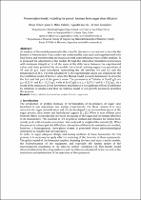| dc.creator | Pérez, Omar | |
| dc.creator | Miño Valdés, Juan Esteban | |
| dc.creator | García, Agustín | |
| dc.creator | González Suárez, Erenio | |
| dc.date.accessioned | 2024-04-18T13:21:40Z | |
| dc.date.available | 2024-04-18T13:21:40Z | |
| dc.date.issued | 2019-03-06 | |
| dc.identifier.citation | Pérez, O., Miño Valdes, J. E., García, A., González, E. (2019). Fermentative kinetic modeling for protein biomass from sugar diversification. The Current Trends in Biomedical Engineering & Biosciences. California : Juniper Publishers, 18(5), p. 5. | es_AR |
| dc.identifier.issn | 2572-1151 | |
| dc.identifier.other | CCPI-FI-A-035 | |
| dc.identifier.other | 24505 | |
| dc.identifier.uri | https://hdl.handle.net/20.500.12219/5263 | |
| dc.description | Fil: Pérez, Omar. Universidad Central Marta Abreu de Las Villas; Cuba. | es_AR |
| dc.description | Fil: Miño Valdes, Juan Esteban. Universidad Nacional de Misiones. Facultad de Ingeniería. Departamento de Ingeniería Industrial; Argentina. | es_AR |
| dc.description | Fil: García, Agustín. Universidad Central Marta Abreu de Las Villas; Cuba. | es_AR |
| dc.description | Fil: González, Erenio. Universidad Central Marta Abreu de Las Villas; Cuba. | es_AR |
| dc.description.abstract | An analysis of the models proposed in the scientific literature is carried out to describe the kinetics of fermentation from a substrate conformed by cane juice and supplemented with final honey and nutrients that are inoculated with autochthonous yeasts of the medium. It is proposed the adjustment of the models through the interactive simulation of processes with minimum integral error of the sums of the differences between the experimental values and those predicted by the models. Initial total reducing sugars concentrations of 45 and 62 g/L were considered maintaining the pH between 4.4 and 5.2 and the temperature at 36 C. The best adjustment to the experimental values was obtained for the free inhibition model of Teisiser, while the Monod model presents deficiencies to describe
the first and last part of the growth curve. The parameters of Teiissier at S0=45 g/L are μm= 0,21 h-1 and KS = 11,21 g/L while at S0=62 g/L are μm= 0,25 h-1 and KS = 23,2 g/L. As a result of the simulation it was determined that there are no significant effects of inhibition by substrate or product and that the Malthos model of cell growth accurately describes this process. | es_AR |
| dc.format | application/pdf | |
| dc.format.extent | 318 KB | |
| dc.language.iso | eng | es_AR |
| dc.publisher | Juniper Publishers | en |
| dc.relation | info:eu-repo/semantics/altIdentifier/doi/10.19080/CTBEB.2019.18.555998 | |
| dc.relation | info:eu-repo/semantics/altIdentifier/urn/https://juniperpublishers.com/ctbeb/CTBEB.MS.ID.555998.php | |
| dc.rights | info:eu-repo/semantics/openAccess | |
| dc.subject | Kinetics | en |
| dc.subject | Models | en |
| dc.subject | Fermentation | en |
| dc.subject | Protein biomass | en |
| dc.subject | Sugar cane | en |
| dc.title | Fermentative kinetic modeling for protein biomass from sugar diversification | en |
| dc.type | info:eu-repo/semantics/article | |
| dc.type | info:ar-repo/semantics/artículo | |
| dc.type | info:eu-repo/semantics/publishedVersion | |



